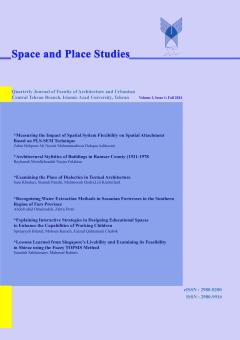Lessons Learned from Singapore's Livability and Examining its Feasibility in Shiraz using the Fuzzy TOPSIS Method
Subject Areas : UrbanismSaeideh Sakhtemani 1 * , Mahmoud Rahimi 2
1 -
2 - Associate Professor, Department of Urban Planning, Faculty of Architecture and Urban Planning, Islamic Azad University, Central Tehran Branch
Keywords: Urban livability, Singapore, Shiraz city, Urban Quality, fuzzy TOPSIS,
Abstract :
Today, on the one hand, the excessive growth of cities and the lack of proper planning and design in the construction of garden cities in the suburbs of the city, and on the other hand, the construction of dense residential complexes have caused the destruction of the urban environment and the reduction of urban livability. Urban livability is one of the basic criteria for measuring the quality of life in urban areas, and by improving it, the quality of urban life can be improved and citizens can be satisfied in various fields. This research aims to benefit from the lessons learned from Singapore in order to achieve urban livability in Shiraz. Despite land constraints, Singapore is ranked as one of the most livable countries. Dr. Cheong Koon Hean, CEO of the Housing and Development Authority of Singapore, presents a model called livable density for social housing design in Singapore. In recent decades, garden cities have been scattered and compact social housing has been built in Shiraz. Therefore, utilizing the livable density model used in Singapore to achieve livability in the city of Shiraz is a useful lesson learned. In this study, the fuzzy TOPSIS multi-criteria decision-making method has been used to analyze the livability status of different regions of Shiraz. First, various livability indicators including population density, green space per capita, and water quality have been identified and related data have been collected.
منابع فارسی
عزیزی، محمد مهدی. (1393)، تراکم در شهرسازی، انتشارات دانشگاه تهران.
سلطانزاده، حسین. (1390)، از خانه تابرج، معماری و راحی داخلی برجهای مسکونی، معماری و فرهنگ شماره 44.
بندرآباد، علیرضا.(1390). شهر زیستپذیر: از مفاهیم تا مصادیق. تهران: انتشارات آذرخش.
پاکزاد، جهانشاه. (1394)، سیر اندیشهها در شهرسازی(2)، انتشارات آرمانشهر.
راجرز، ریچارد، شهرهای پایدار برای سیارهای کوچک، ترجمه خسرو افضلیان (1392)، انتشارات کتابکده کسری.
منابع لاتین
Koon Hean, Cheong (phd), nation – building, Singapore style: better living through density.
Yoon, K. P., & Hwang, C. L. (1995). Multiple attribute decision making: An introduction. Springer.
Evan, R. (2002). Sustainability and livability: Two sides of the same coin. Journal of Urban Planning, 24(2), 98–110.
Evans, J. (2002). Urban sustainability and the role of environmental policy. Urban Studies, 39(5), 1025–1043.
Hedblom, M., et al. (2008). Urban planning and environmental impacts: A review of the global cities. Journal of Environmental Management, 62, 12–23.
Hwang, C. L., & Yoon, K. (1981). Multiple Attribute Decision Making: Methods and Applications. Springer-Verlag.
Ibrahim, M. K., et al. (2002). Urbanization and its effects on public services in developing countries. Environment and Urbanization, 1, 1–16.
National Research Council. (2002). Sustainable Urban Development: The Role of Urbanization in the Environmental and Economic Sustainability of Cities. Washington, DC: National Academy Press.
Yoon, K. P., & Hwang, C. L. (1995). Multiple Attribute Decision Making: An Introduction. Springer-Verlag.

